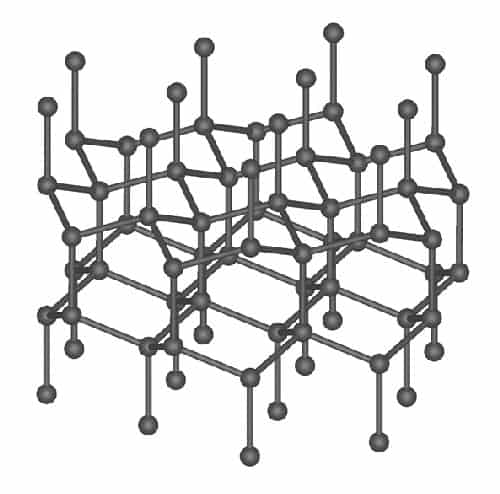
For millennia diamonds have been well established as the hardest material in nature. Then, two years ago, a composite material containing the mineral wurtzite BN was shown to have the same resistance to indentation as diamond.
Now, theoretical work by researchers in China and the US suggests that pure wurtzite BN is significantly harder than diamond. They also predict that Lonsdaleite — with a structure closely related to wurtzite — could be transformed under pressure to become 58% harder than diamond, a new world record (PRL:102.05503).
Hong Sun of Shanghai University and his colleagues report that the very act of indenting wurtzite-BN can force it to undergo a phase transformation into a new crystalline structure with super strength.
A new phase
A material’s hardness is usually taken as a measure of its resistance to external forces. The classic field test is to determine relative “indentation hardness” by crunching together two materials; the harder does the indenting and the weaker gets indented. The fact that diamond has always won these battles is related to its strong, stable carbon lattice, which most commonly takes the form of an octahedron.
Two years ago diamond finally met its match when a small quantity of composite containing the little known wurtzite BN (w-BN) was shown to have the same level of indentation hardness as diamond. Because all other minerals in the composite were known to be significantly weaker than diamond, it led researchers to believe that w-BN may be may possess hardness superior to diamond.
Sun and colleagues focussed on w-BN’s hexagonal crystalline structure, and its stress response to indentation loading. This paid off when their calculations showed w-BN to undergo a structural phase transition when subject to high pressures. The crystal volume remained unchanged but a “bond flip” led to a much increased resistance to indentation.
Armed with this theoretical explanation, the researchers then extended their theory to the related mineral Lonsdaleite. They predict that this naturally-occurring material can be compressed into an even stronger crystalline lattice that 58% more resistant to indentation than diamond.
A machinist’s best friend?
Given the usefulness of diamonds for industrial cutting but their high prices, a lot of practical and theoretical research has gone into finding materials that are as hard and thermally stable as diamond. Lonsdaleite certainly has the strength, according to this new research, but the main problem is its scarcity in nature. “Lonsdaleite and w-BN exist in these metastable structures but they need to overcome the very high potential barriers to transform,” said Sun.
“The kind of heat and pressures needed to produce Lonsdaleite requires the kind energies associated with meteorite collisions,” said Phil Bland, a rock mechanics researcher at Imperial College. Indeed until now naturally-occurring Lonsdaelite has only been found at impact craters like Tunguska in Russia and the Ries crater in southern Germany.
Given this drawback, Sun told physicsworld.com that his team intends to look for ways to produce Lonsdaleite and related materials by artificial processes. “With the fast development of nano science, one might be able to design and synthesize any new kind of artificial materials in the future. The possibility is unlimited,” he said.



